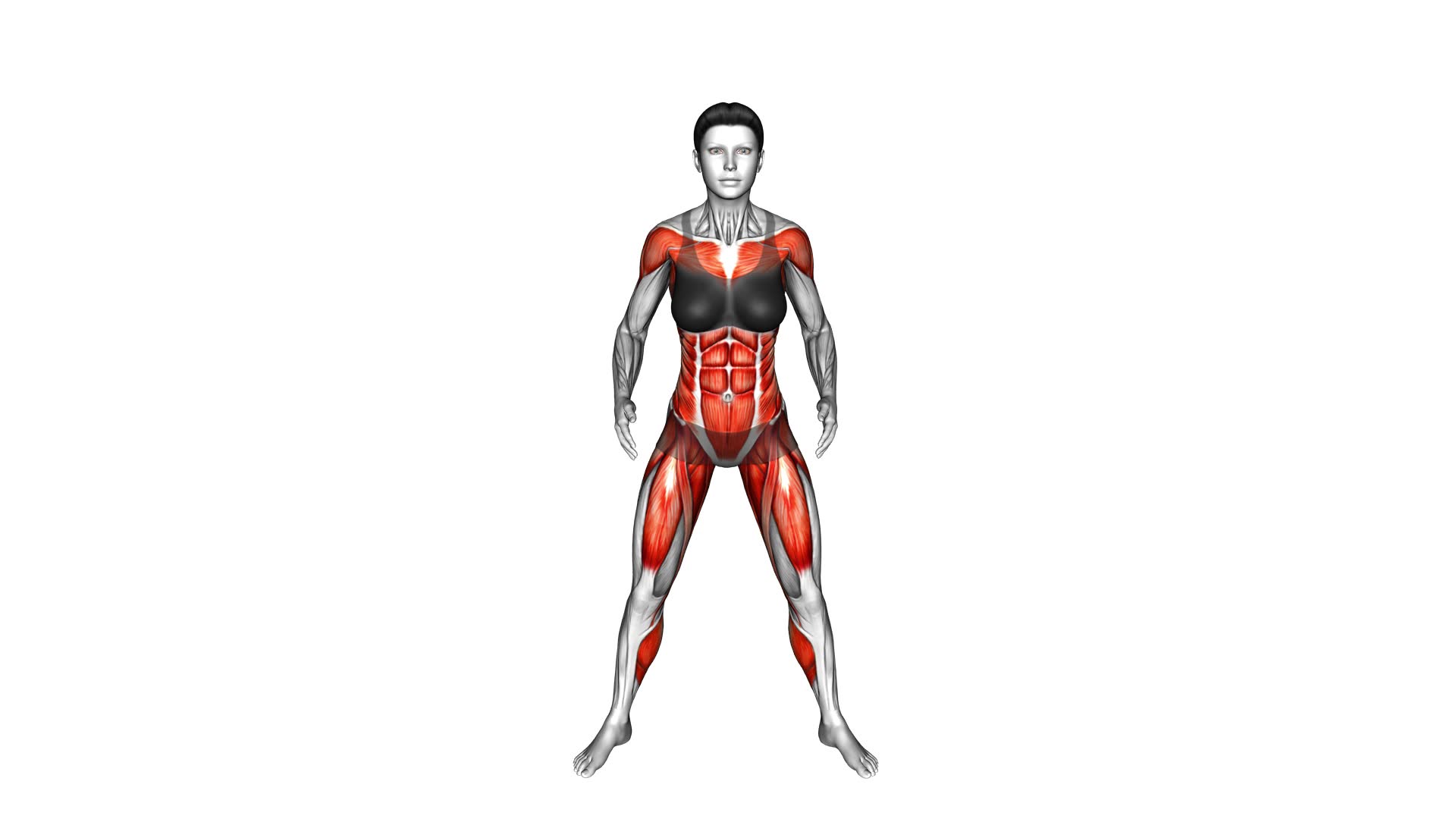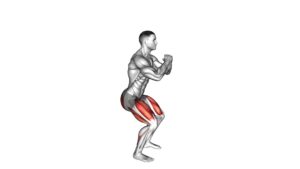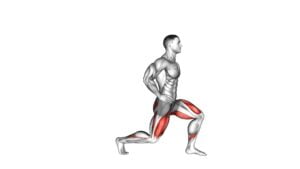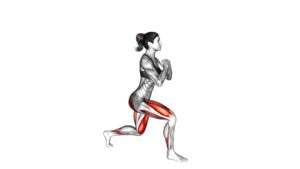Bodyweight Pulse Squat (female) – Video Exercise Guide & Tips

Are you looking for a challenging and effective exercise to strengthen your lower body? Look no further than the bodyweight pulse squat, specifically designed for women.
Watch This Exercise Video
This exercise targets your quads, glutes, and hamstrings, helping you build strength and tone.
In this video exercise guide, we'll show you the proper form and technique, modifications for beginners, advanced variations, and common mistakes to avoid.
Get ready to squat your way to a stronger, more sculpted physique!
Key Takeaways
- Targets quads, glutes, and hamstrings
- Builds strength and tone in lower body
- Increases muscle endurance and power in legs
- Enhances stability and balance
Benefits of the Bodyweight Pulse Squat
Improve your lower body strength and stability with the Bodyweight Pulse Squat's benefits.
Squats are a fundamental exercise for strengthening your lower body, and the Bodyweight Pulse Squat is a great variation to add to your routine. This exercise targets your glutes, quadriceps, and hamstrings, helping you achieve stronger and more defined legs.
By incorporating the Bodyweight Pulse Squat into your workouts, you can significantly improve your lower body strength. The pulsing motion adds an extra challenge, forcing your muscles to work harder and overcome plateaus. As you continue to perform this exercise regularly, you'll notice increased muscle endurance and power in your legs.
Not only does the Bodyweight Pulse Squat target your lower body muscles, but it also enhances your stability. The pulsing motion engages your core, promoting better balance and control. This is especially beneficial for athletes and individuals looking to improve their performance in sports or activities that require lower body strength and stability.
In addition to its physical benefits, the Bodyweight Pulse Squat can also be a great motivational exercise. It allows you to challenge yourself and push through your limits, ultimately leading to a sense of accomplishment and progress.
Proper Form and Technique
Now that you're ready to perfect your bodyweight pulse squat, let's discuss some key points to keep in mind.
First and foremost, squat depth is crucial for maximizing the effectiveness of this exercise.
Engaging your core throughout the movement won't only help you maintain proper form but also strengthen your abdominal muscles.
Lastly, be aware of common form mistakes, such as leaning too far forward or allowing your knees to collapse inward.
Squat Depth Importance
Achieve optimal squat depth to ensure proper form and technique during the exercise. Squat depth variations can range from shallow to deep, and it's important to find the right depth for your body.
Deep squats, where you lower your hips below parallel, offer several benefits. Firstly, they activate more muscles, including the glutes, hamstrings, and quadriceps, leading to greater strength gains. Secondly, deep squats increase mobility and flexibility in the hips and ankles, improving overall athletic performance. Additionally, they enhance balance and stability, as you're required to engage your core and maintain proper alignment throughout the movement.
So, don't be afraid to go deep in your squats and reap the rewards.
Now, let's dive into some core engagement tips to maximize the effectiveness of your workout.
Core Engagement Tips
To ensure proper form and technique during the Bodyweight Pulse Squat exercise, focus on engaging your core throughout the movement. Core stability is crucial for maintaining proper alignment and balance, and it helps to protect your lower back.
As you lower into the squat position, imagine pulling your belly button towards your spine to activate your deep core muscles. This will help you maintain a stable and strong center of gravity.
Additionally, pay attention to your breathing techniques. Inhale deeply as you lower down into the squat, and exhale forcefully as you push back up. This will help you generate power and maintain control throughout the exercise.
By prioritizing core engagement and utilizing proper breathing techniques, you can maximize the effectiveness of the Bodyweight Pulse Squat and achieve optimal results.
Keep up the great work!
Common Form Mistakes
Are you making any common form mistakes while performing the Bodyweight Pulse Squat exercise?
Proper form and technique are crucial for maximizing the benefits of this exercise and preventing injury.
One common mistake isn't maintaining a neutral spine throughout the movement. Make sure to keep your chest up, shoulders back, and core engaged.
Another mistake is letting your knees cave inwards. To avoid this, push your knees outwards in line with your toes.
Additionally, be mindful of your depth. Going too low can strain your knees, while not going low enough limits the effectiveness of the exercise.
Remember, the Bodyweight Pulse Squat is just one variation of the squat, and improving your form won't only enhance your performance but also transfer to other squat variations.
Now, let's explore some modifications for beginners to help you progress in your fitness journey.
Modifications for Beginners
If you're new to squatting, don't worry. There are easier squat progressions and simplified movement variations that can help you build strength and confidence.
You can start with shallow squats or use assistance tools like a stability ball or a chair to support you as you lower down.
Easier Squat Progressions
Start with modified squat variations to make it easier for beginners. Assisted squats can be a great option for those who are new to squats or have limited mobility. These variations involve using a chair or stability ball for support. Simply squat down as far as you can while keeping your balance, and then use the chair or stability ball to help you back up. This allows you to focus on proper form and gradually build strength and flexibility in your legs.
Additionally, working on squat mobility exercises can help improve your range of motion and make squatting easier. Once you feel comfortable with assisted squats and have improved your squat mobility, you can move on to simplified movement variations that will challenge you even more.
Simplified Movement Variations
You can try modified squat variations to make the movement easier as a beginner. Squat variations are a great way to build strength and improve your overall fitness level.
As a beginner, it's important to start with simpler movements to ensure proper form and avoid injury. One modification you can try is the box squat. This variation involves squatting down onto a box or bench, which helps to reduce the range of motion and provides support.
Another modification is the wall squat, where you lean against a wall and slide down into a squatting position. This variation helps to improve your squatting technique and build strength in your lower body.
Assistance Tools for Beginners
To assist beginners in their fitness journey, incorporating modifications and assistance tools can be beneficial. Here are four assistance tools and beginner modifications that can help you progress and build strength:
- Resistance bands: Attach a resistance band around your thighs to provide extra support and stability during the pulse squat. This can help you maintain proper form and prevent any unnecessary strain.
- Stability ball: Place a stability ball against a wall and lean against it while performing the pulse squat. This will provide additional support for your lower back and help you maintain balance.
- Chair or bench: Use a chair or bench to assist with the squatting motion. Start by sitting on the chair or bench and then stand up, focusing on engaging your glutes and thighs. Gradually decrease the height of the chair or bench as you build strength.
- Wall support: Stand with your back against a wall and perform the pulse squat while sliding your back up and down the wall. This will help you maintain proper alignment and provide support as you work on building strength in your lower body.
Advanced Variations and Progressions
Exploring higher-level adaptations of the bodyweight pulse squat will enhance your strength and coordination. Once you have mastered the basic technique, you can challenge yourself with advanced modifications and techniques to take your workout to the next level.
One advanced variation is the jump squat. Instead of pulsing at the bottom of the squat, you explosively jump up into the air, extending your legs fully. This adds an element of plyometric training, which can improve your power and explosiveness.
Another advanced technique is the pistol squat. This is a one-legged squat where you extend one leg out in front of you while squatting down on the other leg. It requires a great deal of balance, strength, and flexibility in the hips and ankles.
To further intensify your workout, you can incorporate weights. Holding a dumbbell or kettlebell in front of your chest while performing the pulse squat will increase the resistance and challenge your muscles even more.
Remember to always focus on maintaining proper form and technique, even when attempting advanced variations. Start with lighter weights and gradually increase as you become more comfortable and confident. Push yourself, but listen to your body and avoid overexertion.
Common Mistakes to Avoid
When attempting advanced variations of the bodyweight pulse squat, it's important to be aware of common mistakes to avoid. Proper breathing and muscle activation are essential for maximizing results and preventing injury. Here are four common mistakes to watch out for:
- Shallow Squats: One common mistake isn't squatting deep enough. Make sure to lower your body until your thighs are parallel to the ground, engaging your glutes and quads fully.
- Rounded Back: It's crucial to maintain a neutral spine throughout the exercise. Avoid rounding your back, as this puts unnecessary strain on your lower back and can lead to injury. Keep your chest lifted and shoulders back.
- Lack of Core Engagement: Your core plays a significant role in stabilizing your body during the movement. Engage your core muscles by drawing your belly button in towards your spine, providing stability and protecting your back.
- Holding Your Breath: Proper breathing is key to efficient muscle activation. Inhale as you lower into the squat and exhale as you push back up. This helps oxygenate your muscles and enhances their ability to work effectively.
By avoiding these common mistakes and focusing on proper breathing and muscle activation, you can perform the bodyweight pulse squat with optimal form and achieve better results.
Now, let's dive into the next section to discover tips for maximizing your workout.
Tips for Maximizing Results
To maximize your results with the bodyweight pulse squat, incorporate these tips into your workout routine.
First and foremost, focus on maximizing the intensity of each rep. Engage your glutes, quads, and hamstrings as you lower into the squat position, and then explode upwards to really activate those muscles. Remember, it's not about how many reps you do, but how effectively you perform each one.
In addition to intensity, pay attention to your workout frequency. Consistency is key when it comes to seeing results. Aim to incorporate the bodyweight pulse squat into your routine at least two to three times a week. This will ensure that you're giving your muscles enough stimulus to grow and strengthen over time.
To keep yourself motivated and avoid plateauing, consider adding variations to the bodyweight pulse squat. You can try adding weights, such as dumbbells or a barbell, to increase the resistance and challenge your muscles even more. Additionally, you can experiment with different tempos, like slowing down the lowering phase or adding a pause at the bottom of the squat.
Frequently Asked Questions
How Many Calories Does the Bodyweight Pulse Squat Burn?
The bodyweight pulse squat is an effective exercise for burning calories and improving flexibility. When you perform this exercise, you engage multiple muscle groups, which increases your heart rate and helps you burn calories.
Additionally, the pulsing motion helps to stretch and strengthen your leg muscles, leading to improved flexibility over time.
Can the Bodyweight Pulse Squat Help Improve Flexibility?
The bodyweight pulse squat can be a great exercise for improving flexibility. By engaging your lower body muscles and performing controlled pulses, you can increase your range of motion and stretch your muscles.
This exercise also helps in improving balance and increasing lower body strength. So, if you're looking to become more flexible and strengthen your legs at the same time, the bodyweight pulse squat is definitely worth incorporating into your fitness routine.
How Often Should the Bodyweight Pulse Squat Be Performed for Optimal Results?
To get optimal results from the bodyweight pulse squat, you need to perform it regularly. The frequency of your workouts will depend on your fitness level and goals. Aim to do the bodyweight pulse squat at least 2-3 times a week.
This will help improve your lower body strength, endurance, and flexibility. Don't forget to mix it up by trying different variations of the bodyweight pulse squat to challenge your muscles and keep things interesting.
Keep pushing yourself and you'll see the benefits in no time!
Can the Bodyweight Pulse Squat Help Strengthen the Core Muscles?
The bodyweight pulse squat is a fantastic exercise to strengthen your core muscles. By engaging your core while performing this exercise, you aren't only working your legs but also targeting your abdominal and back muscles. This helps improve stability, balance, and overall core strength.
Additionally, incorporating variations such as jump squats or adding weights can provide a more challenging workout, further enhancing the benefits for your overall fitness.
Is the Bodyweight Pulse Squat Suitable for Individuals With Knee Problems?
If you have knee problems, it's important to consider modifications or alternatives to the bodyweight pulse squat.
While this exercise can be effective for strengthening the lower body, it may put strain on your knees.
To protect your knees, you can try doing modified squats with less depth or using a chair for support.
Alternatives like glute bridges or step-ups can also work your lower body without aggravating your knee issues.
Always listen to your body and adapt exercises to suit your needs.
Conclusion
Incorporating bodyweight pulse squats into your workout routine can help you build strength and tone your lower body. By focusing on proper form and technique, you can maximize the benefits of this exercise.
Whether you're a beginner or advanced, there are modifications and progressions to suit your fitness level. Avoid common mistakes and follow these tips to achieve great results.
Start pulsing and feel the burn as you sculpt and strengthen your legs and glutes!

Author
Years ago, the spark of my life’s passion ignited in my mind the moment I stepped into the local gym for the first time. The inaugural bead of perspiration, the initial endeavor, the very first surge of endorphins, and a sense of pride that washed over me post-workout marked the beginning of my deep-seated interest in strength sports, fitness, and sports nutrition. This very curiosity blossomed rapidly into a profound fascination, propelling me to earn a Master’s degree in Physical Education from the Academy of Physical Education in Krakow, followed by a Sports Manager diploma from the Jagiellonian University. My journey of growth led me to gain more specialized qualifications, such as being a certified personal trainer with a focus on sports dietetics, a lifeguard, and an instructor for wellness and corrective gymnastics. Theoretical knowledge paired seamlessly with practical experience, reinforcing my belief that the transformation of individuals under my guidance was also a reflection of my personal growth. This belief holds true even today. Each day, I strive to push the boundaries and explore new realms. These realms gently elevate me to greater heights. The unique combination of passion for my field and the continuous quest for growth fuels my drive to break new ground.







